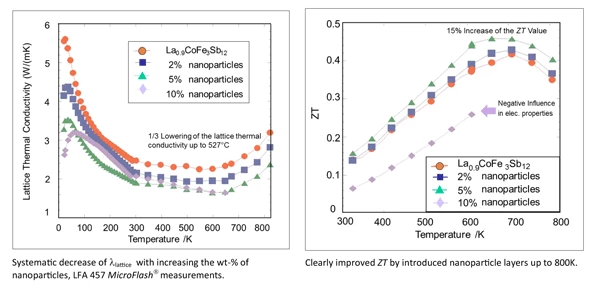thermoelectric
Skutterudite
Cubic skutterudite materials of the form (Co,Ni,Fe)(P,Sb,As)3, have a potential for high ZT values due to their high electron mobility and high Seebeck coefficient.
Unfilled CoSb3-based skutterudites are disadvantaged by their inherently large Thermal ConductivityThermal conductivity (λ with the unit W/(m•K)) describes the transport of energy – in the form of heat – through a body of mass as the result of a temperature gradient (see fig. 1). According to the second law of thermodynamics, heat always flows in the direction of the lower temperature.thermal conductivity, which lowers their ZT value. However, these materials contain voids into which low-coordination ions (usually rare earth elements) can be inserted. These alter the Thermal ConductivityThermal conductivity (λ with the unit W/(m•K)) describes the transport of energy – in the form of heat – through a body of mass as the result of a temperature gradient (see fig. 1). According to the second law of thermodynamics, heat always flows in the direction of the lower temperature.thermal conductivity by producing sources for lattice phonon scattering and decrease Thermal ConductivityThermal conductivity (λ with the unit W/(m•K)) describes the transport of energy – in the form of heat – through a body of mass as the result of a temperature gradient (see fig. 1). According to the second law of thermodynamics, heat always flows in the direction of the lower temperature.thermal conductivity due to the lattice without reducing Electrical Conductivity (SBA)Electrical conductivity is a physical property indicating a material's ability to allow the transport of an electric charge.electrical conductivity. This makes these materials behave like a PGEC (phonon-glass, electron crystal). It is proposed that in order to optimize ZT, phonons which are responsible for Thermal ConductivityThermal conductivity (λ with the unit W/(m•K)) describes the transport of energy – in the form of heat – through a body of mass as the result of a temperature gradient (see fig. 1). According to the second law of thermodynamics, heat always flows in the direction of the lower temperature.thermal conductivity must experience the material as they would in a glass (high degree of phonon scattering– lowering the Thermal ConductivityThermal conductivity (λ with the unit W/(m•K)) describes the transport of energy – in the form of heat – through a body of mass as the result of a temperature gradient (see fig. 1). According to the second law of thermodynamics, heat always flows in the direction of the lower temperature.thermal conductivity) while electrons must experience it as a crystal (very little scattering – maintaining the Electrical Conductivity (SBA)Electrical conductivity is a physical property indicating a material's ability to allow the transport of an electric charge.electrical conductivity).
Lattice Thermal ConductivityThermal conductivity (λ with the unit W/(m•K)) describes the transport of energy – in the form of heat – through a body of mass as the result of a temperature gradient (see fig. 1). According to the second law of thermodynamics, heat always flows in the direction of the lower temperature.Thermal Conductivity and Figure of Merit of La0.9CoFe3Sb12
The effect of introducing a nanoparticle layer in La0.9CoFe3Sb12 in order to reduce the thermal conductivity is investigated up to 550°C. The thermal conductivity (l)was calculated by using the heat capacity (Specific Heat Capacity (cp)Heat capacity is a material-specific physical quantity, determined by the amount of heat supplied to specimen, divided by the resulting temperature increase. The specific heat capacity is related to a unit mass of the specimen.cp) predetermined in the DSC 404 F1 Pegasus®®. The lattice thermal conductivity was found by calculating the electrical thermal conductivity using the Wiedemann-Franz relationship and subtracting it from ltotal.
At 452°C, the ZT exhibits its maximum, and the 5 wt.-% nanocomposite shows the highest ZT with an improvement of nearly 15% over that of the control sample that contains no nanoparticles (orange dots). These results show that nanoparticles introduced in already optimized skutterudite systems can further reduce the thermal conductivity and therefore improve ZT within a broad temperature range.
